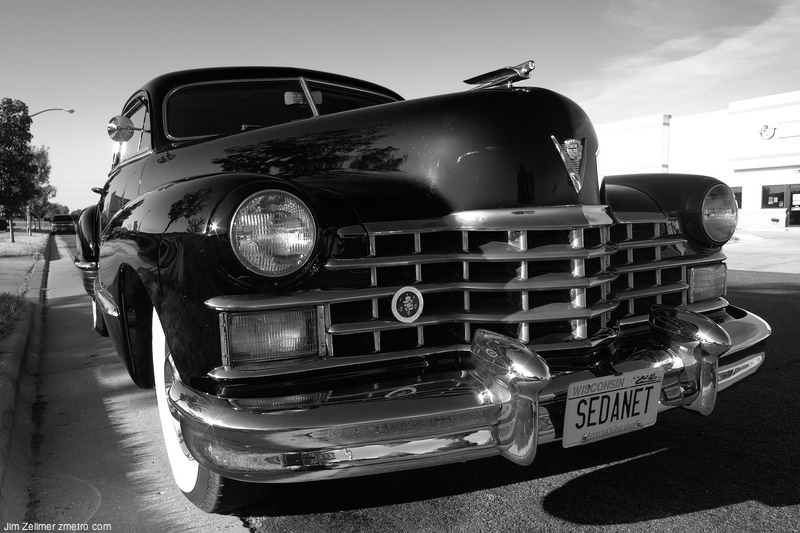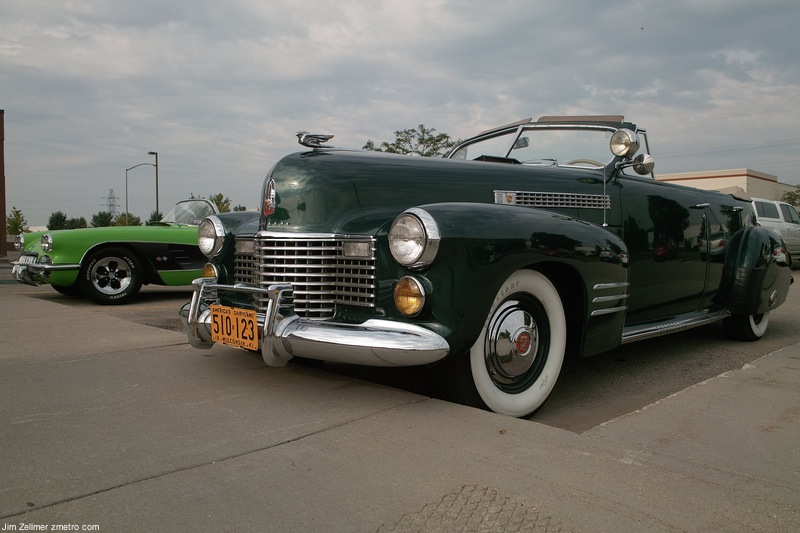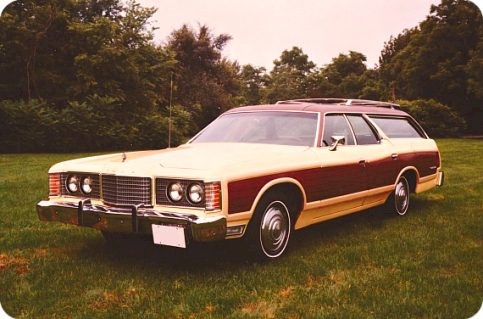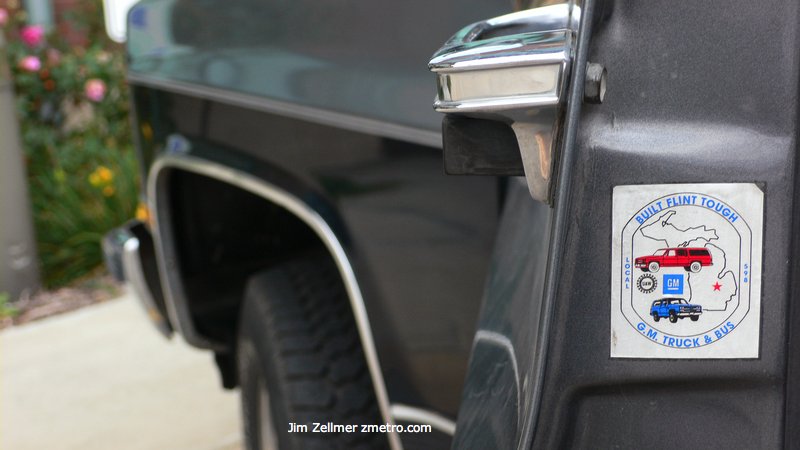 1940’s?
1940’s?
Category: Cars
Classic Cadillac

A Scooter Rant
But I reserve particular ire for the burgeoning scooter movement that’s being written about on an alarmingly frequent basis in the media with every new report of another record price for a barrel of oil. Now, don’t get me wrong, because I have nothing against scooters. I like them, as a matter of fact. They can be fun, efficient and even cool in the right circumstances. But presenting scooters as a viable transportation option for the masses in this country is flat-out irresponsible.
Let me backup here for a second and repeat that sentence: “…can be fun, efficient and even cool in the right circumstances.” Guess what, folks – riding your Vespa down Woodward Avenue, Michigan Avenue or Fifth Avenue does not constitute “the right circumstances.” Americans clearly watched too many Italian movies from the 60s and became enamored with the whole “sweater tied around the neck/sunglasses on top of your head/voluptuous girl hanging on the back of the scooter” thing, and this latest gas frenzy has started to warp their thinking, big time.
Thinking of Summer: Aix-en-Provence
 Thoughts of summer as Winter continues in Madison. Note the fashionable sushi delivery vehicle, a Smart Car and the smartly dressed pedestrian. Summer in Provence. Much more on Aix-en-Provence here [map]
Thoughts of summer as Winter continues in Madison. Note the fashionable sushi delivery vehicle, a Smart Car and the smartly dressed pedestrian. Summer in Provence. Much more on Aix-en-Provence here [map]
Oil Demand, the Climate and the Energy Ladder
Energy demand is expected to grow in coming decades. Jeroen van der Veer, 60, Royal Dutch Shell’s chief executive, recently offered his views on the energy challenge facing the world and the challenge posed by global warming. He spoke of the need for governments to set limits on carbon emissions. He also lifted the veil on Shell’s latest long-term energy scenarios, titled Scramble and Blueprints, which he will make public next week at the World Economic Forum in Davos, Switzerland. Following are excerpts from the interview:
Q. What are the main findings of Shell’s two scenarios?
A. Scramble is where key actors, like governments, make it their primary focus to do a good job for their own country. So they look after their self-interest and try to optimize within their own boundaries what they try to do. Blueprints is basically all the international initiatives, like Kyoto, like Bali, or like a future Copenhagen. They start very slowly but before not too long they become relatively successful. This is a model of international cooperation.
The Dealer Made Me Do It
First off, I’m not excusing auto dealers. Or lenders.
They have a moral and business responsibility to try to stop their customers from doing something stupid, such as buying a vehicle with a sticker price that will stick them with an oppressive debt.
But customers have responsibilities, too. It is their purchase, their money and their car payments. It is up to them, more than anyone else, to know their financial limitations and not cross them.
Yet, so many consumers today buy too much vehicle. Then, when the financial squeeze becomes eye-popping, they look for someone to blame. The dealership and lender make nice targets. Seldom do the debt-ridden blame themselves.
I pondered that while reading a Los Angeles Times article headlined, “New Cars That Are Fully Loaded – With Debt.”
The story tells how some Americans of average means roll over an existing loan on an expensive vehicle in order to get another expensive vehicle. They end up with two loans in one, when they couldn’t afford one.
From the LA Times article:
Americans haven’t just been taking out risky mortgages for homes in the last few years; they’ve also been signing larger automobile loans for significantly longer terms than they used to.
As a result, people are slipping into a perpetual cycle of automobile debt that experts think could lead to a new credit crunch extending from dealerships to driveways and all the way to Wall Street.
The $100M Giveaway
Put down your highlighter and don’t bother checking your lottery tickets, because the State of Texas has announced a $100 million winner. Only it’s actually 30,000 drivers living in ozone goal non-attainment areas, and it will be doled out $3,000 at a time. And if you or your family are constrained by a certain income level, if you drive a vehicle 10 years old or older that’s been registered in the county for over a year and passed an emissions test up to 15 months ago, yet failed one recently, then the state is willing to pay you $3,000 to scrap your vehicle and get something newer. All in the name of clean air.
Considering that Texas is notoriously clutch-fisted with money for public projects, particularly when the bank account starts with $100 million, this is big news. Especially if your vehicle’s more than 10 years old and has extremely high mileage – or the kind that brings virtually nothing when you go to trade it in – this is a money-for-nothing proposition that can benefit you tremendously. So, before we go on with today’s column, check out the rules for this program at www.driveacleanmachine.com, and then call 1-800-898-9103 to apply for your voucher.
Requiem for a Station Wagon

One of the rare examples of altruism in pistonheads concerns the (nearly extinct) American station wagon. They passionately defend the one automotive genre that the vast majority of American consumers wouldn’t be caught dead in (excepting a hearse). Why so much love for a car shape that’s been fading from the American scene for the best part of 25 years? The passion comes from recognition. The reality we’ll have to blame on Darwin and his stupid birds.
Wagons increase a car’s cargo space without altering the donor car’s fundament shape. They’re a bit heavier and generally a little shakier than their sedan sibling, but still offer car-like driving dynamics. This is important to enthusiasts, who value driving dynamics sur tout. Ironically, pistonheads hate compromises; generally speaking, they don’t buy wagons. But they recommend them to others– especially SUV owners– based on the combination of handling and hauling.
Is It the New Automotive Century Yet?
Finally, we are being treated to a good old-fashioned bare-knuckles fistfight. The biggest and most respected players in the automobile industry are trashing each other’s technological plans for future automobiles, while promoting their own concepts as the future of the industry. It’s an elevated debate, not a product-vs.-product dustup. What I found most fascinating about all of this was Carlos Ghosn’s position that, one day in the near future, only electric cars might be allowed in some of the most congested cities in the world. There’s little doubt in my mind that he’s probably right; he’s just looking at the European viewpoint on that issue, not necessarily the Japanese.
